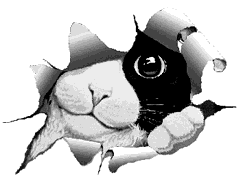
GERMAN REX

ORIGIN
The story begins in August 1951, when Dr Rose
Scheuer-Karpin found, among the numerous feral cats in the
grounds of the former Hufeland Krankenhaus at Berlin-Buch-one black and rather
tame female cat whose seems unusual;because of her soft and wavy coat, and her
seemingly alim legs, she called her Laemmchen, which means "lambkin" in German.
A short time after she had takenin, Blacky, a black male kitten; when Blacky had
growned up into a beautiful tom cat, he became Laemmchen's mate. Soon, there
were black kittens gambolling about: some of them had a small white mark under
the chin, other a white marking between the hindlegs, but the fur was normal in
all of them. This was also the case in the litters to follow. This means that
the gene for the quality must be present in both parents to show in the
offspring. As Blackie was a normal domestic cat, all the kittens which he
fathered carried only a single gene for Laemmchen's fur, and another for a
normal fur; in 1953 headlines appeared in the British press, exciting for cat
lovers and scientists alike : "The curly cat is here". In the summer of 1953,
Blackie died and Laemmchen remained alone. After several months she became
interested again in cat company; one of her sons, Fridolin, spent a few days
together, and nine weeks later she produced four kittens, two of which had a
normal coat, with straight medium long hair, and two had the short silky
permanent wave! Thus the hereditary nature of the wavy fur in the German Rex was
finally established. German cat breeders were slow to recognize the German Rex.
It was only after the news from Paris reached them that interest was aroused for
the curly cat. The German Rex was first shown at Dresden in 1964, and a year later
also in East Berlin. Visitors from West Germany and other western countries who
had seen the Cornish Rex before the German Rex found the latter most attractive
Laemmchen died in December 1964. Some of her live in the States, a few others in
Paris, and one or two in Berlin.
ASPECT
The head is round; it has a strong chin and well developed
cheeks. The nose has a slight indentation at the top.
The eyes are set at a good distance from the nose; the eyes are brilliant in
colour which should harmonize with the particular coat colour.
The body is medium in size and length, strong and muscular.
The German Rex have soft, wavy, rippled coats which lack guard hairs; all
Colours are allowed including all varieties with white, distribution as in
Bi-Colour and Tri-Colour cats.
CHARACTER
Playful,
intelligent, and friendly,the
German Rex is delightful, distinctively different, constantly charming and
captivating. Even tempered and very affectionate, they also appeal because of
their extremely quiet voices.
Rexes
need people, and given a choice will spend most of their time with humans;
no-one could be immuned to their magnificent coat.
The German Rex is
truly one of natures miracles.
CARE
German Rex were sometimes prone to suffer from a benign eczema over their lower spine, for which no cause could be found and it always disappeared spontaneously.